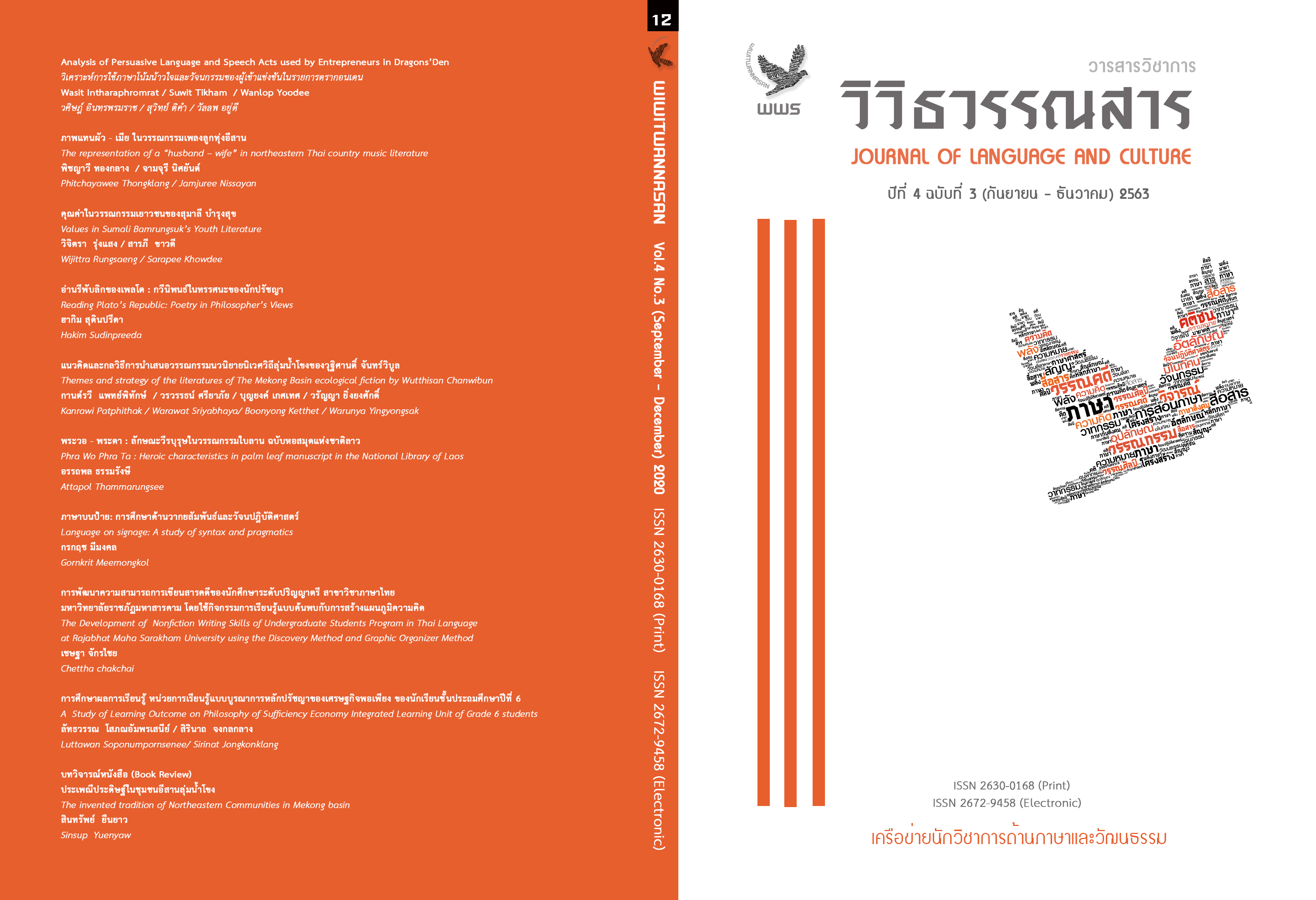ภาษาบนป้าย: การศึกษาด้านวากยสัมพันธ์และวัจนปฎิบัติศาสตร์
Main Article Content
บทคัดย่อ
บทความวิจัยนี้มีวัตถุประสงค์เพื่อศึกษาลักษณะภาษาที่ปรากฏอยู่บนป้ายในด้านวากยสัมพันธ์และวัจนปฏิบัติศาสตร์ วิธีการศึกษา ได้แก่ ถ่ายภาพป้ายในซอยสุขุมวิท 3 (นานาเหนือ) และซอยสุขุมวิท 63 (เอกมัย) ซอยละ 100 ป้าย รวม 200 ป้าย จากนั้น
นำข้อมูลที่ได้มาวิเคราะห์ ผลการศึกษาพบว่า ลักษณะเด่นของการใช้ภาษาด้านวากยสัมพันธ์ที่ปรากฏอยู่บนป้ายมี 5 ประเด็น ได้แก่ 1. ใช้โครงสร้าง “Ø + คำกริยา + คำนาม(สิ่งที่ขาย)” และการละคำ 2. ใช้โครงสร้างกริยาเรียง 3. ใช้โครงสร้าง “คำนาม + คำนาม” เพื่อแสดงประเภทธุรกิจและบริการ 4. ใช้การย้ายตำแหน่งหัวข้อหลัก และ 5. ใช้การสลับตำแหน่งคำ ด้านวัจนปฏิบัติศาสตร์พบ 5 ประเด็น ได้แก่ 1. ใช้ภาษาแสดงแสดงเจตนาด้วยคำพูด 2. ใช้ภาษาแสดงความสุภาพ 3. ใช้วัจนกรรมอ้อม 4. ใช้ภาษาโฆษณา และ
5. ใช้ภาษาที่เกี่ยวข้องกับบริบทของสังคม
Article Details
ลิขสิทธิ์ของบทความเป็นของวารสาร การพิมพ์ซ้ำจะต้องได้ร้บการอนุญาตจากบรรณาธิการวารสาร
เอกสารอ้างอิง
Ariel, M. (2008). Pragmatics and Grammar. Cambridge University Press.
Aristova, N. (2016). Rethinking cultural identities in the context of globalization: linguistic landscape of Kazan, Russia, as an emerging global city. Proceedings of International Conference on Communication in Multicultural Society. Moscow. Russia.
Austin, J. L. (1962) How to Things with Words. Oxford: Clarendon, 4-11.
Bhandhumedha, N. (2010). Waiyakon thai (In Thai). [Thai Grammar]. Academic publishing project. Faculty of Arts, Chulalongkorn University.
Brown, P., & Levinson, S. C. (1987). Politeness: Some Universals in Language Usage. Cambridge: Cambridge University Press.
Chuaychoowong, M. (2019). Linguistic Landscape on Campus: A Case Study of a Thai University. Prodeedings of Rangsit University International Research Conference. 1242-1249.
Depadung, S. (2006). Watchanapatibutsat bueangton (In Thai) [Introduction to Pragmatics]. Research Institute for Languages and Cultures of Asia, Mahidol University.
Firth, J.R. (1957). Papers in linguistics 1934-1951. Oxford: Oxford University Press.
Grice, H. P. (1975). Logic and Conversation. In the Discourse Reader, 76-88. Edited by Jaworski, A. & Coupland, N. London: Routledge.
Hymes, D. (1962). The ethnography of speaking. In T. Gladwin &W. C. Sturtevant (Eds.), Anthropology and Human Behavior. Washington, DC: Anthropology Society of Washington. 13–53.
Indrambarya, k. (2009). Kan la prathan nai phasa thai (In Thai) [Null Subject in Thai]. Proceedings of Research Exibition of Kasetsart University Annual Conference, Thailand.
Kaeobut, P. (2020). Khwamphrom dan phasachin khong tha-akatsayan nanachat changwat Suratthani kap mice city: kansueksa tam Naeo Phumthat cheng phasaasat (In Thai) [Chinese readiness of Surat Thani international airport with nice city: the study of linguistic landscape]. Journal of Humanities, Naresuan University, 17 (1), 89-104.
Kemson, R. (1975). Presupposition and the Delimitation on Semantics. Cambridge University Press.
Kroeger, R. P. (2005). Analyzing Grammar: An introduction. Cambridge University Press.
Lakoff, R. (1973). Language and woman’s place. Language in Society, 2 (1), 45-80.
Landry, R., & Bourhis, R. (1997). Linguistic landscape and ethnolinguistic vitality: an empirical study, Journal of Language and Social Psychology, 16 (1). 23-49.
Leech, G., N. (1983). Principles of Pragmatics. Essex: Longman.
Levinson, S. C. (1983). Pragmatics. Cambridge: Cambridge University Press.
Mettajit, V. (2015). Watchanakam tamni Nakrian khong khru nai sam changwat chaidan tai (In Thai) [Reprimand of Teachers towards Students in Three Southern Border Provinces in Thailand] (Master’s thesis). Prince of Songkla University, Pattani.
Pattaranawig P., & Boonkhachorn, T. (1974). Kan chai phasa kap kankhotsana (In Thai) [Thai Language Usage of advertisement]. Anksormsartpicharn Journal, 7-17.
Potjanalawan, P. (2017). “Phumnam” samphasaa: kanchaiphasaa thai angkrit chin bon paichue satharana phuea kanthongthiao nai khet thetsaban nakonlampang (In Thai) [Three accents of toponym: using Thai, English and Chinese on public signs in Lampang municipality]. Local administration journal, 10 (4), 120-138.
Prapobratanakul, C. (2016). Inside the shop names: hybridity, language awareness and globalization in the linguistic landscape of a local commercial neighborhood in Bangkok. Manusya: Journal of Humanities. Special issue 22, 26-37.
Seangyen, C. (2015). Phumithat thang phasaasat chak pai khotsana nai amphoe Mueang changwat Udonthani (In Thai) [Linguistic landscape on billboards in Mueang district, Udonthani Province]. Mekong Chi Mun Art and Culture Journal, 1 (2), 13-36.
Searle, J. R. (1969). Speech Acts. London. Cambridge University Press.
Singhasiri, W. (2013). Linguistic landscape in the State Railway Station of Thailand: the analysis of the use of language, Proceedings of ECLL 2013: The Inaugural European Conference on Language Learning “Shifting Paradigms: Informed Responses. July 18-21. UK. 124-132.
Thongtong, T. (2016). A linguistic landscape study of signage on Nimmanhemin Road, a lanna Chiang Mai chill-out street. Manusya, Journal of Humanities, Special Issue.
Wang, J. (2015). Linguistic Landscape on Campus in Japan— A Case Study of Signs in Kyushu University. Intercultural Communication Studies.
Wangphusit, K. (2012). Chue thurakit kankha nai yan sayamsakhwia : kansueksa tamnaeo phumithat thang phasasat (In Thai) [Business names in the area of Siam Square: a linguistics landscape study] (Master’s thesis). Chulalongkorn University, Bangkok.
Warotamasikkhadit, U. (1997). Fronting and backing topicalization in Thai. The Mon-Khmer Studies Journal. (27), 303-306.
Wiroonpun, P. & Panyamatheekul, S. (2019). Pai ran ahan rimthang yaowarat lae yan chatuchak: Kanwikro tamnaeo Phumithat Sanyasat (In Thai) [Roadside Restaurant signs in Yaowarat and Chatujak: Semiotic Landscapes Analysis] (Master’s thesis) Srinakharinwirot University, Bangkok.
Wu, H. T, S. & Huebner, T. (2020). “A new chinatown? authenticity and conflicting discourses on Pracha Rat Bamphen Road”. Journal of Multilingual and Multicultural Development. 41 (9), 1-19.
Yanhong, M. (2015). Chiang Mai’s Linguistic Landscape in the Tourist Attraction Areas: A Study on the English Language Use on Signs. (Master’s thesis). Naresuan University, Phitsanulok.


